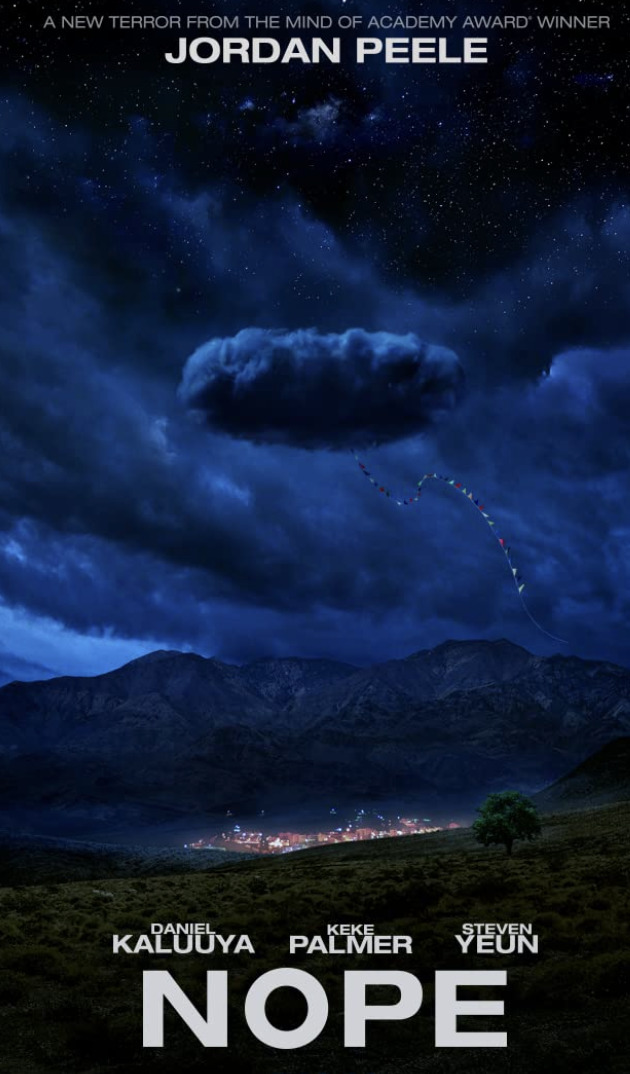
Synopsis : A man and his sister discover something sinister in the skies above their California horse ranch, while the owner of a nearby theme park tries to profit from the mysterious, otherworldly phenomenon.
Rating: R (Some Violence/Bloody Images|Language Throughout)
Genre: Sci-Fi, Horror, Mystery & Thriller
Original Language: English
Q&A with with director Jordan Peele, actor Keke Palmer, producer Ian Cooper, editor Nicholas Monsour, and composer Michael Abels of the feature film “Nope.”
Q: Jordan, what made you make an alien-invasion film as your third feature, and what is it about the UFO that made it the right conduit for the ideas you wanted to explore?
JP: To address the genre-bending element of it and the fact that it resembles a lot of films, but doesn’t quite resemble any film… Early on, Alex Bovaird, our costume designer, who’s an incredible artist, identified in the script [what] she called “spectral.” It had a spectrum of ideas and flavors in it, and a lot of that came from how the movie was conceived and how it was made.
For example, When I first made “Get Out,” I knew I wasn’t going to be able to have a movie that had a huge budget or anything. So I crafted a little bit of a magic trick in that way. For this film, I had this wonderful privilege of feeling like I was going to get to make the movie that I wanted to make, and to try and push those boundaries.
That opened me up to a writing process that allowed the film to evolve into what it needed to be when it needed to be that. So I began writing. The first notion — the first “hook” — was this idea of that I could convince an audience they’re watching “Close Encounters of a Third Kind” but then they realize at some point they’ve been watching “Jaws.” That’s obviously a very reductive way to put it, but that feat alone would create this entirely new experience in an entirely new film. That was the hook.
And I knew I wanted to make a spectacle. I knew I wanted to make a blockbuster — something I wouldn’t have been able to do a few years earlier. In trying to figure out what this film was, what I was trying to say, I really had to go inward and explore my relationship to this idea of “spectacle” and why, intrinsically, a plot was going to be baked in this notion that I said, at some point, “I can do this thing so I must do it. I must go [there].”
[I had] the blinding ambition that I couldn’t let myself off the hook. That’s why the satire; the Gordy and the Juke plot line emerges as a commentary on myself — my own career, my own trauma within the career, and my feelings of confusion. I’m writing it in the midst of the George Floyd protests and in the aftermath of the murder. It was very clear that — I always wanted to do it — I needed to make a movie about Black Joy.
I’m a Black horror movie maker in a lot of ways, so it’s hard to pull that off in this joyous manner but I said “No, we’ve got to do that with this one.” That’s why you have “Nope” — this weird, fucked-up Frankenstein of a film. This amazing group of people “got” it from the very beginning, [and] helped me pull off what I previously thought was impossible. Kaleidoscopic. That was the word. It wasn’t spectral — it was kaleidoscopic.
Q: Your film is also about the business of spectacle, and obviously, you’re dealing with the film industry in the present, but you connected it directly to the history of cinema itself. When did Eadweard Muybridge figure into this film?
JP: Ian Cooper, my producer, gave me a book — it was called “Erasure” [by Percival Everett, 2001]. I consider [him] my closest creative ally and confidant. He’s really the one who takes the reins on most things when I have to be intensely focused on the actors and script, and makes this movie happen. I’m also privileged [in that] he’s also one of my best friends from high school, and a brilliant artist in his own right. I have the privilege of working with somebody who understands me on this core level. He brilliantly identified this Muybridge clip as something that was a cross-section of some of the things that I wanted to make a film about.
IC: It was really uncanny, too, because there was so much connectivity to Muybridge beyond that first animal locomotion plate [Animal Locomotion Plate 626, 1887]. Muybridge was a pioneer of sky replacement — which we ended up having to do in this film in terms of creating a vast landscape. Muybridge added clouds to complete the long exposure that he couldn’t have because of cloud movement. So as we were reading this book, we were working on ideas, something that we’re reading or thinking about comes to inform us over and over again and it becomes an indelible element. So it felt like the origin of the motion picture, this notion of trickery, of replacing the sky. We were like, “Okay this is informing us that this needs to be a guiding principle.”
JP: The thing that really stood out to me, of course, was this realization that the Black jockey on this clip didn’t have… There’s no trail of what happened to him or who he was. It became this central focal point. The spirit of this film was this erased rider. This idea that the very first star — who could have been regarded as the very first star — had been discarded.
That became the spirit of the Haywood lineage and this thing worth fighting for is being seen, participating in our rightful place as part of the makers of dreams in this industry. And, by the way, the whole concept is Otis senior — a character who, in many ways, Keke as Emerald is challenging — the father. In my mind, this is a made-up story. The lineage of this original character may or may not really be connected. The father had a way of changing the truth. But the idea is still pure that this is an icon worth embracing and saving.
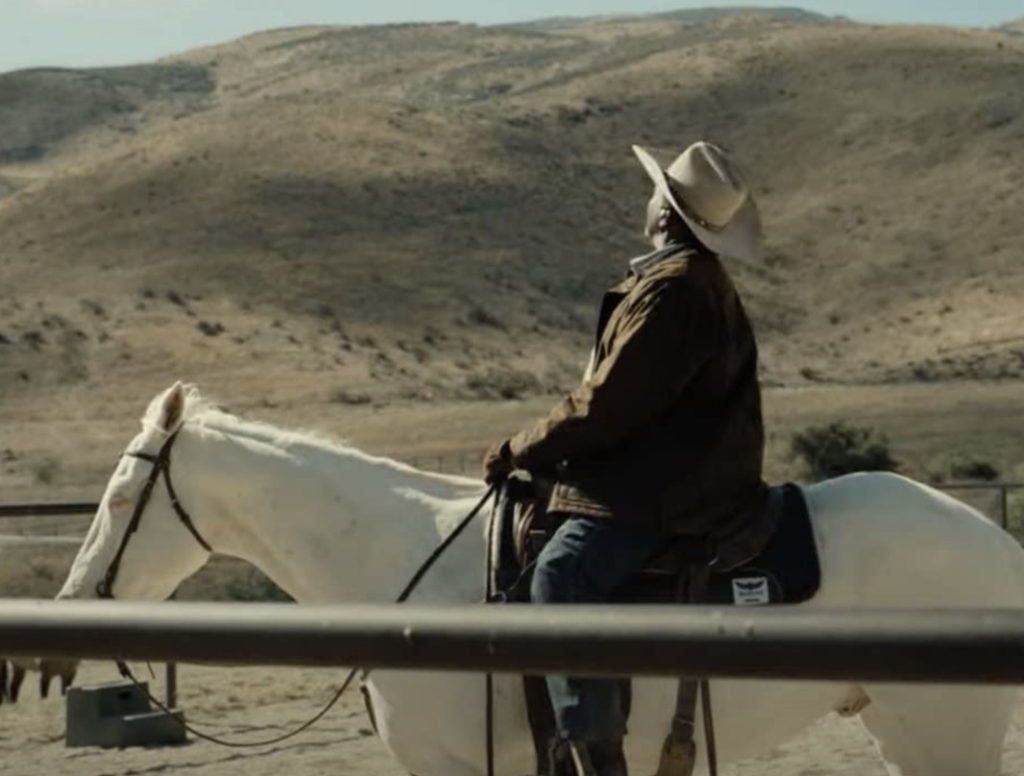
Q: Keke, your performance as Emerald is incredible. How did you get to this point, of turning Emerald into this flesh-and-blood character? What did you respond to about Emerald?
KP: It was all very natural. He called and said “I want to share this with you.” He lightly told me what the project was about, he didn’t over-push it. But he said, “I want you to check out the script and this character.” I was so excited to read it, and once I did, I thought I knew where the movie was going. Okay, you have this brother, he’s brooding, and I’m kind of the jokester, and I thought I knew where the movie was going from that point.
But, as [Jordan] so well put it, it’s a bit of a Frankenstein and I saw that my character was so much more than what would usually be on the surface for any character’s archetype. That’s when I started really getting into the knowledge, and also the originality of what makes Jordan Peele a storyteller, a director, and an artist. What he was doing was all so intentional.
The research on the character that I was doing with him was all about those different things that he put into her, what they represented at different times and how they tied into the storyline as a whole. We would have these conversations. Sometimes,they’d be totally about the script and sometimes, they’d be about his inspirations. Sometimes they’d be about me and how I connect to the film as an actor and about my process of finding my own journey with this character that I then can inform him.
It was a very personal, intimate relationship that he was open to having with me that helped me define who Emerald was, which was a really cool and unique experience. I was extremely open and ready to be transformed. Emerald is a character that I’d never gotten a chance to play [before].
It may have had elements of things I could tap into before but never did. I haven’t had the opportunity to transition into a character over the course of a film the way I was able to do with Emerald. I don’t think her kind of character is really that common in general — let alone being a black female. For me, that was the greatest challenge in playing this most exciting part — being able to bridge those different beats of transformation in one movie.
Q: Jordan, when you’re in the writing stage how much backstory do you give to your characters and to the alien? Is there a lot of subtraction afterward, or do you withhold a lot of information at first?
JP: Yeah, you’re kind of building these characters with everyone — primarily your actors, who, at some point, you really hope and want to become the experts on your characters, to know them even better than you so you can ask them how they want to react. But from the beginning to the end of the process, the story and the characters are being crafted. Michael [Wincott, who plays Antlers] has a big part in the character and understanding how we’re meant to feel when OJ [Keith David] has just seen the UFO for the first time and comes back and Emerald is like, “What happened?” Michael transitions into this wonderful, magical, eerie, almost ambling thing for a moment, where all of a sudden, the childhood view of UFOs is alive and you feel this brother-and-sister bond.
Then you’ve got Nick [Monsour, editor] here, who is one of the very, very, great editors. What we’re doing in the post phase is absolutely obsessing over these characters. I’d say they begin in some way to crack them, I have to understand who I am in the character. That’s the bond that I have with someone like Keke. When we started talking about Emerald, we were talking about the part of me that was on Key and Peele — the part of me that decided to be out in front and wanted that attention. I was a child actor but not a child star. We went through coming up through on selling yourself as part of your identity is a real challenge. I think we bonded.
KP: Absolutely. It was the coolest experience. There would be moments where we’re going through different parts of this script, this story, from when we first rehearsed to when we were actually on set, or when we had an idea that happened that morning. I would be listening, my head would be down, I’d be listening to what Jordan’s saying, I’m like, man this is deep. And I look up and there’d be just this one little tear falling. Man, this brother’s deep.
JP: I’m not afraid to cry as a director.
KP: And he’s chill! He’d be like, “That’s what happens” and tears are falling. I’m like, “Are you all right?” But he keeps going and he’s like “Yeah, yeah. So that’s the thing.” And then he just walks out.
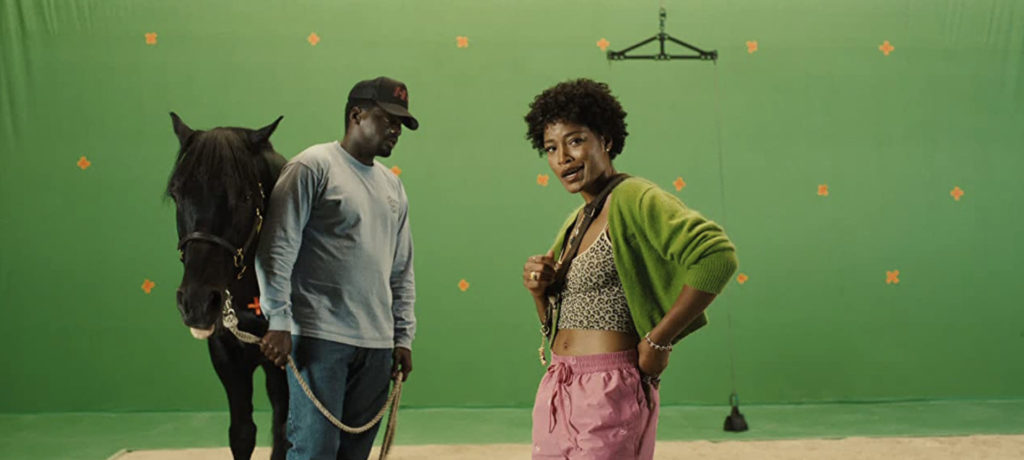
Q: Michael, let’s turn to the score which is so important in orchestrating the film’s tonal shifts. This is your third film working with Jordan. What were your initial conversations about the film?
MA: Jordan’s been great about letting me read the script when he feels ready to share it. It’s really great to feel like you’re one of the first [pairs of] eyes on something really special. He really seeks feedback from people. The feedback is something that feeds his creative process. Because he’s so interested in different genres, I’m really wanting to step into whatever he wants to do with that genre. In your introduction, you were great about saying [that] some of it is loving and some of it is satirical and some of it’s biting. Music can really attenuate how that’s perceived.
We talked a lot about how much of it is satire, what percentage is an homage and parody, and all these different things should be in the music. That affects our conversations a lot. With this film there [are] certain parts of the music that are horror, suspenseful and intense, and there are parts that are very much old school classic Western. Parts of the score are action-adventure, finally, when we get to it. It’s important that all those things feel like they all have a place where they meet.
There’s also the relationship of OJ and Emerald — how warm and familial [it is] and a representation of their heritage. The music helps us feel that bond between them, even when, externally, it looks like they’re not getting along. We talked a lot about those dynamics. At that point — he doesn’t tell me, “I really want to hear this in a musical way” because he’s really good about giving you instructions that inspire you to do whatever your best work is.
KP: Man, that’s so true. It’s really a hard skill, but he does it well.
MA: It can come in the form of something that can be heady, like the way I’ve just been explaining it, or it can be a joke of something. I can’t think of one from “Nope” right now, but [in] “Get Out” there’s a scene where there’s a video. One of the things I enjoy doing is the source music. A lot of times, I’ll do the source music for Jordan’s films because it’s an inside joke for all of us. In this very, very tragically made video, there’s tragic music to the video that’s been added, and that’s actually the theme from “Get Out” but done in a very happy, nice way that you would never notice.
Before I did it, Jordan just said, “It has to sound like a really bad ED commercial.” For whatever reason, I thought I knew what that should sound like. That’s an example of the feedback he gives you that, as an artist, will inspire you. How many ways can you take that? And yet, you feel you know exactly what to do. For each of the genres, he would give me a hilarious example of something — sometimes he speaks in terms of what the audience is supposed to be feeling. That’s a thing he does that’s unique among the directors I’ve worked with. He doesn’t just say, “The character is feeling this”.
He’ll say, “This is the point where the audience should be saying…” And suddenly, he embodies every moviegoer you’ve ever seen and what they should be saying in their minds. They’ll be saying, “Oh no, he shouldn’t be doing that” or “What’s going on here?” He knows exactly what he wants the audience to be feeling. Therefore, I understand that all of us are in the same field to deliver an experience for the audience, and he’s really good about helping me see what each scene and what each moment is designed to do for the audience’s experience.
JP: About trusting your collaborators — a lot of people think that film is about the director’s “vision.” It means that they know what the movie is going to look like — and that’s kind of a false lead. You know what you need out of the film, what you want the audience to feel and what you want them to experience. But I think when it’s really working — when you’re really making a great movie — you’re putting a lot of trust in these fine people that you’ve gathered. Hoyte Van Hoytema, the great cinematographer — who unfortunately can’t be here — just extended what was possible for me to do in film and for me to conceive of.
You realize when you’re making a movie that you’re trying to capture a feeling. But the movie you’re trying to make isn’t something you can conceive of if you’re really getting people together that are going to watch your back and are going to be doing their best work that they’ve ever done. For example, when I’m working with Nick, my principle of working is essentially that I have to feel like there’s not one movie here but there’s an infinite amount of movies here. And there’s an infinite amount of ways to get it wrong, too.
The idea that there’s one movie here is very limiting and we end up finding one movie, but the pathway to get there involves a lot. For example, [Nick] going on fantastical editing explorations that may come back in a circle, and then we’re back at square one but we’ve learned something. So anyway, I just want to highlight [it] because the amount of work that Nick does is tremendous and you see it all here [indicates the screen]. All the work that you don’t see is also on a different level of what he’s sifted through and figured out for me.
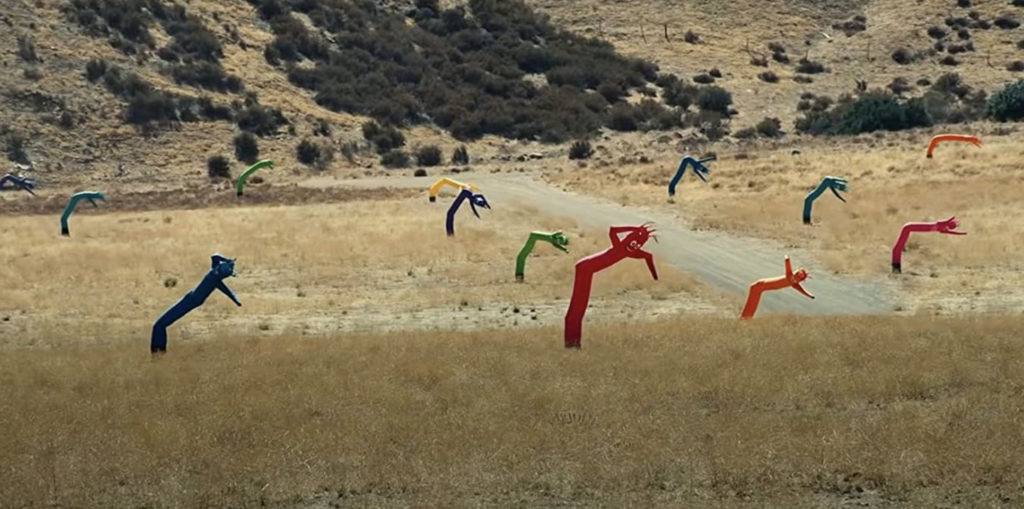
Q: Nick, how did you work with Jordan on the editing and how did you see the writing phase develop into that stage?
NM: It is, like everybody else says about working with Jordan on one of his movies, pretty much unlike working on any other movie. All the same technical stuff applies, but it’s the most creatively rewarding, because you know you’re safe in an environment and with an idea and creative vision that you know is going somewhere great the whole time. But you’re free to pitch many things. I’m always trying to get on the inside of what’s inspiring the decisions for everybody — the actors, Jordan, the set designers — and understand the logic. Editing is a weird thing where film is so much more than what you can describe.
You can’t quite pin down what’s great or bad about something in words, and yet that’s what you have to do when you’re working with somebody. We have this other language where we can throw ideas back and forth as long as you trust each other enough. There’s a freedom where you get to go down a lot of experimental avenues. You can triangulate a good idea that’s right through five wrong ideas. That takes time, trust and energy, but is so much fun. It’s such a treat to work on something where it’s alive the whole time. There wasn’t just this idea that was perfect in a director or filmmaker’s head and then everything is just a series of disappointments because it’s not perfect after that. Instead, it’s an idea that then gets made alive by all the contributions, and it’s alive the whole time.
IC: It’s also rarely “no” — that’s one of the best parts of the process. You’ve created something, spent all weekend making, and then you show it. It gets digested, discussed, broken apart, and reborn in other iterations of exploration. That’s the part that’s mind-blowing to watch happen.
JP: I love movies. I truly believe something that may not be true. I believe that a single person can make a really great piece of art. But I do believe the old “Obama-ism” — “What we can do together is greater than what we can do alone.” It’s true. I can write a script. But all of a sudden when you add all of these people who are masters of their craft to that script, you have something completely transcendent. Has anyone seen this film before? People are coming back to see the same film because they were taken somewhere. Whether they liked where they were taken or not — because some parts of the movie are uncomfortable and disorienting — we come back to this thing that’s impossible for somebody to make. And it is impossible for somebody to make. You need a hundred people to do something like that. That’s why I love movies. I’ve always been fascinated with film because it’s the collection of everybody’s dream come true in a way — you hope — through that process.
Q: How did you come up with the final design on the Jean Jacket [the alien] because it starts out with the stereotype UFO and then it unfurls?
JP: You are the Jean Jacket’s perfect prey. When I was originally conceiving the animal, [I was] trying to do all these things that we don’t see enough in these movies, that we’re not necessarily picturing when we picture an alien. One of the first places I went was underwater, which isn’t completely novel in itself. I was looking at the properties of these animals that are able to exist in a three-dimensional experience, the way Jean Jacket would fly throughout space and exist in that space.
So we got something that relates to air the way so many creatures we know relate to water, animals like the cuttlefish and on planet Earth, the peacock. There are certain animals that use mesmerization as a primary tool. We knew Jean Jacket from the very beginning, and had many amazing artists working on Jean Jacket. But from the very beginning, I knew it had to be a creature that was a vision and that you can’t look away from. Then, it’s got you when you do look at it.
Q: What have you learned from the making of each of your films, especially “Nope”?
JP: Wow, that’s deep. I’m going through this process right now as I try to figure out what to do for the next project. One thing I’ve learned about myself — as my life develops in this amazing direction, where so many of my dreams have come true — I have to push at ways of understanding and challenging myself. This breakthrough that I was talking about here, where I realized this in a really big way, oh, every character has to somehow represent a flaw that I see in myself and work through that. This was my most personal film so far, so I feel like I have to continue with that instinct to ask myself tough questions.
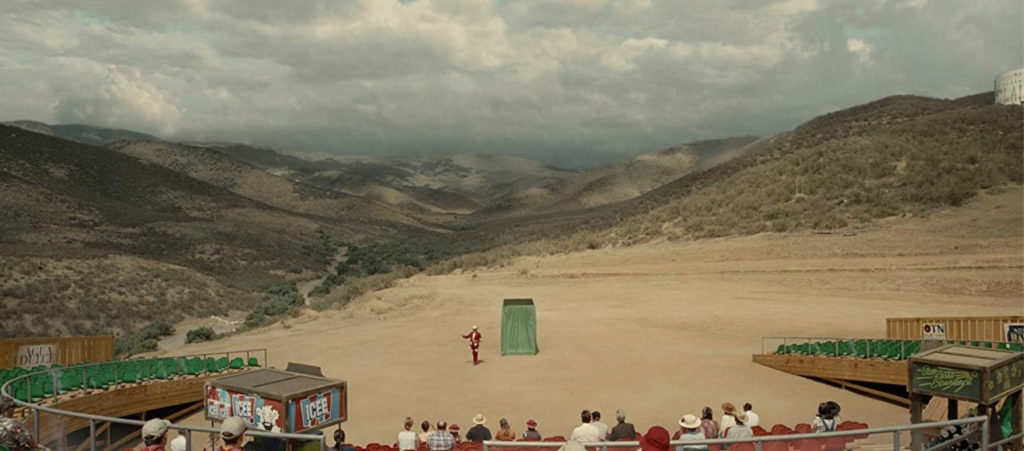
Q: The films that you curated around this film [The Lost Rider: A Chronicle of Hollywood Sacrifice], were these films that you had your crew watch?
JP: There’s several of these films that have probably been referenced in several moments. Certainly, with each of these collaborators, there’s a different level of understanding of what this list is about. We watched “King Kong” [Merian C. Cooper and Ernest B. Schoedsack’, 1933] with the crew. It was something I wanted to show them a film that was of the utmost technical awe. When I sat down to watch the film, I was amazed because I was thinking about being ambitious technically and thinking in terms of this groundbreaking movie. Just trying to replicate what they did, now, seems impossible to me, so that was inspiring and I wanted to inspire the crew as well. It is so very much about this idea of selling spectacle, about movie making, and it’s marred [by] this very exploitative and offensive take on exotic masculinity and this tribe. So the movie is a masterpiece spectacle about and of exploitation in itself. In many ways, it’s a spirit animal. No pun intended.
Q: You also selected quite a few Corey Feldman films. Can you tell us about your motivation for that, especially the final film, “The Birthday” [dir. Eugenio Mira, 2004], which appears to have not yet had a U.S. theatrical release?
IC: We went to Corey Feldman’s house.
JP: Yeah, and I had invited him to see “Nope” at the premiere. Part of the connection is hard for me to truly put into words. But it does in many ways connect to this idea of the vanishing spectacle and this lineage of the Rider in Hollywood. How I get from that original Black jockey to Corey Feldman — you know, a white teen icon — at this very specific time who then made this film that we saw which we thought was extremely magnetic, cinematic, and a real what-the-f***-did-I-just-watch film. Starring Corey Feldman in 2004 it never came out, this missing film. Recognizing how much intrinsic DNA this film shares with mine — I built a bit of a run to tell that story of the missing jockey, in part, through Corey.
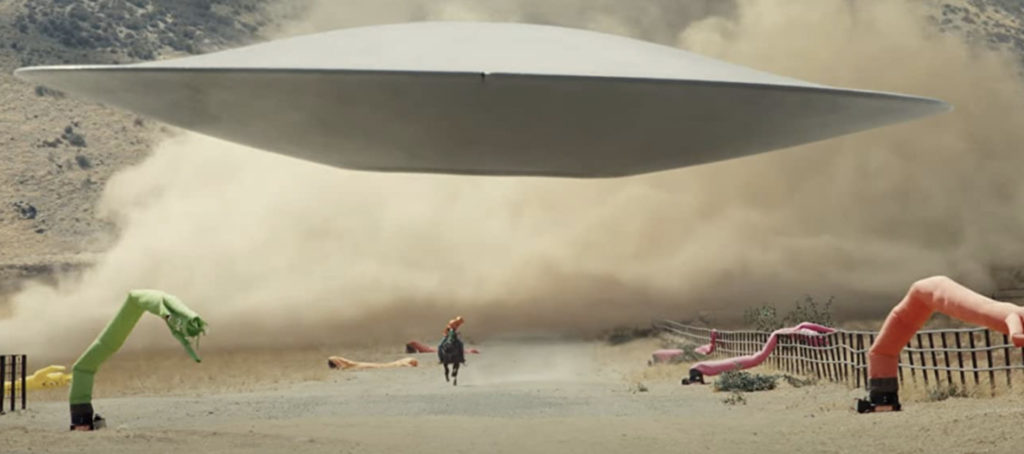
Check out more of Nobuhiro’s article.
Here’s the trailer of the film.


Very informative information on your blog,Amazing post it is very helpful and knowledgeable Thank you.